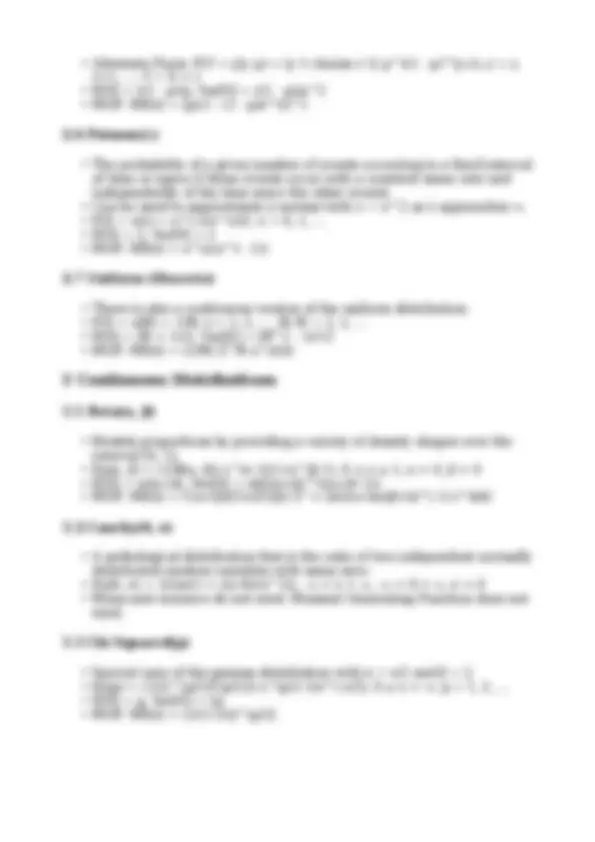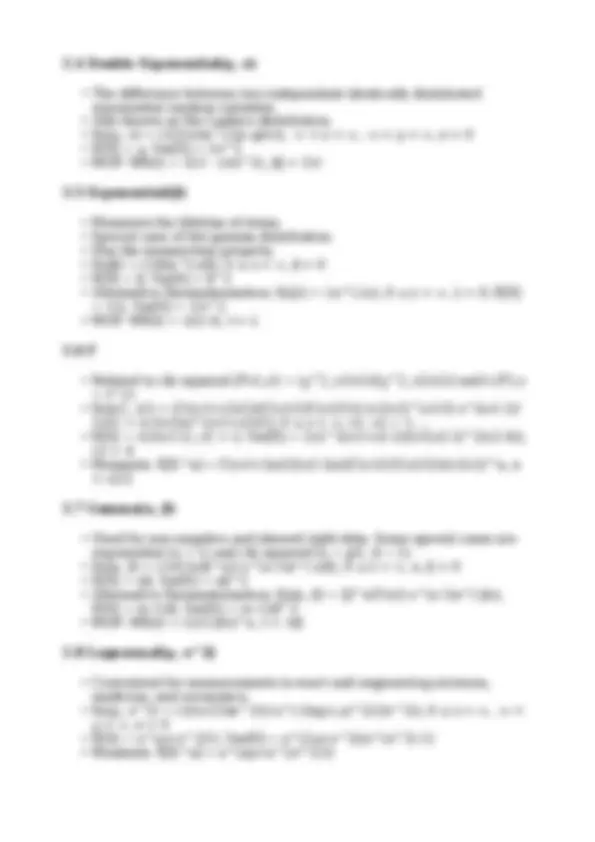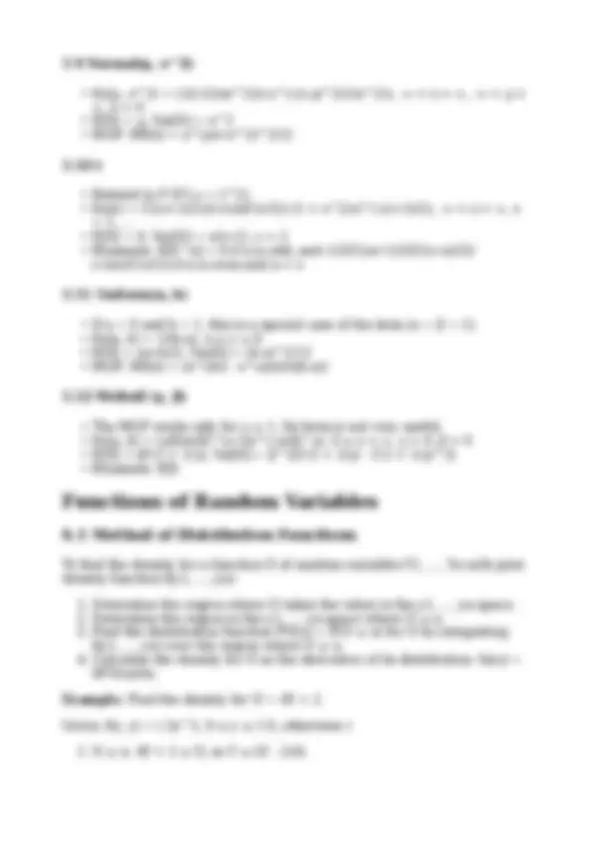





Study with the several resources on Docsity

Earn points by helping other students or get them with a premium plan


Prepare for your exams
Study with the several resources on Docsity

Earn points to download
Earn points by helping other students or get them with a premium plan
Community
Ask the community for help and clear up your study doubts
Discover the best universities in your country according to Docsity users
Free resources
Download our free guides on studying techniques, anxiety management strategies, and thesis advice from Docsity tutors
A comprehensive overview of probability distributions and functions, covering both discrete and continuous distributions. It delves into key concepts like set notation, additive law, conditional probability, and the law of total probability. The document also explores various distributions, including bernoulli, binomial, geometric, hypergeometric, negative binomial, poisson, beta, cauchy, chi-squared, double exponential, exponential, f, gamma, lognormal, normal, t, uniform, and weibull. It further explains functions of random variables and methods for finding their densities, such as the method of distribution functions and the method of transformations. An invaluable resource for students studying probability and statistics, offering a clear and detailed explanation of fundamental concepts and their applications.
Typology: Summaries
1 / 6

This page cannot be seen from the preview
Don't miss anything!




Sample Space (S) : The set of all possible sample points (i.e., the collection of all the sample events). Complement (A^c) : The set of all elements not in the event A; P(A^c) = 1 - P(A). Union (A ∪ B) : The set of all elements either in set A, B, or both. Intersection (A ∩ B) : The set of all elements occurring in both sets A and B. Empty Set (∅) : The set where neither sets A nor B have elements in common. If A ∩ B = ∅, then sets A and B are mutually exclusive or disjoint.
The probability that at least one of the two events A and B occurs is: P(A ∪ B) = P(A) + P(B) - P(A ∩ B)
If events A and B are mutually exclusive, then: P(A ∪ B) = P(A) + P(B)
The probability that both events A and B occur is: P(A ∩ B) = P(A)P(B|A) = P(B)P(A|B)
Two events are said to be independent if any one of the following holds: - P(A ∩ B) = P(A)P(B) - P(A|B) = P(A) - P(B|A) = P(B)
Let B1, ..., Bk be a partition of the sample space S, where every Bi has P(Bi)
- Then, for any event A: P(A) = Σ P(A|Bi)P(Bi)
Bayes' Rule (Conditioning on a Partition): P(Bj|A) = (P(A|Bj)P(Bj)) / Σ P(A| Bi)P(Bi)
Random Variable : A numeric variable whose value is determined by the outcome of a chance experiment. Its domain is the sample space. Statistics : The use of samples to make statements about populations (i.e., inference).
Simple Random Sample (SRS) : Selection of n individuals from a population of size N so that every set of n individuals has the same probability of selection. The number of possible SRS are: N!/(n!(N-n)!).
2.1 Bernoulli(p)
Counts successes of a single trial with Boolean responses. Special case of the binomial distribution when n = 1. P(X = x|p) = p^x(1 - p)^(1-x); x = 0, 1; 0 ≤ p ≤ 1 E[X] = p, Var[X] = p(1 - p) Moment Generating Function (MGF): MX(t) = (1 - p) + pe^t
2.2 Binomial(n, p)
Counts successes of n independent trials with Boolean responses (samples with replacement). Related to the multinomial distribution, a multivariate version of the binomial distribution. Can be approximated by the Poisson as n approaches ∞. P(X = x|n, p) = (n choose x) p^x(1 - p)^(n-x); x = 0, 1, 2, ...; 0 ≤ p ≤ 1 E[X] = np, Var[X] = np(1 - p) MGF: MX(t) = [pe^t + (1 - p)]^n
2.3 Geometric(p)
Determines the probability until the first success. Y = X - 1 is negative binomial (1, p). The distribution is memoryless: P(X > s|X > t) = P(X > s - t). P(X = x|p) = p(1 - p)^(x-1); x = 1, 2, ...; 0 ≤ p ≤ 1 E[X] = 1/p, Var[X] = (1 - p)/p^ MGF: MX(t) = p/(1 - (1 - p)e^t), t < -log(1 - p)
2.4 Hypergeometric
Counts successes of n trials with Boolean responses (samples without replacement). If K << M and N, the range of x = 0, 1, 2, ..., K will be appropriate. P(X = x|N, M, K) = (M choose x)(N-M choose K-x)/(N choose K); x = 0, 1, 2, ..., K; M-(N-K) ≤ x ≤ M; N, M, K ≥ 0 E[X] = KM/N, Var[X] = KM(N-M)(N-K)/N^2(N-1) Moment Generating Function does not exist.
2.5 Negative Binomial(r, p)
Counts fails of n trials with Boolean responses. Can be approximated by a geometric with n = 1. P(X = x|r, p) = (r+x-1 choose x) p^r(1 - p)^x; x = 0, 1, ...; 0 ≤ p ≤ 1
3.4 Double Exponential(μ, σ)
The difference between two independent identically distributed exponential random variables. Also known as the Laplace distribution. f(x|μ, σ) = (1/(2σ))e^(-(|x-μ|/σ)), -∞ < x < ∞, -∞ < μ < ∞, σ > 0 E[X] = μ, Var[X] = 2σ^ MGF: MX(t) = 1/(1 - (σt)^2), |t| < 1/σ
3.5 Exponential(β)
Measures the lifetime of items. Special case of the gamma distribution. Has the memoryless property. f(x|β) = (1/β)e^(-x/β), 0 ≤ x < ∞, β > 0 E[X] = β, Var[X] = β^ Alternative Parameterization: f(x|λ) = λe^(-λx), 0 ≤ x < ∞, λ > 0; E[X] = 1/λ, Var[X] = 1/λ^ MGF: MX(t) = λ/(λ-t), t < λ
Related to chi squared (Fν1,ν2 = (χ^2_ν1/ν1)/(χ^2_ν2/ν2)) and t (F1,ν = t^2). f(x|ν1, ν2) = (Γ((ν1+ν2)/2)/(Γ(ν1/2)Γ(ν2/2))) (ν1/ν2)^(ν1/2) x^((ν1-2)/ 2)/(1 + (ν1/ν2)x)^((ν1+ν2)/2); 0 ≤ x < ∞; ν1, ν2 = 1, ... E[X] = ν2/(ν2-2), ν2 > 2; Var[X] = 2ν2^2(ν1+ν2-2)/(ν1(ν2-2)^2(ν2-4)), ν2 > 4 Moments: E[X^n] = Γ((ν1+2n)/2)(ν2-2n)/(Γ(ν1/2)Γ(ν2/2))(ν1/ν2)^n, n < ν2/
3.7 Gamma(α, β)
Used for non-negative and skewed right data. Some special cases are exponential (α = 1) and chi squared (α = p/2, β = 2). f(x|α, β) = (1/(Γ(α)β^α)) x^(α-1)e^(-x/β), 0 ≤ x < ∞, α, β > 0 E[X] = αβ, Var[X] = αβ^ Alternative Parameterization: f(x|α, β) = (β^α/Γ(α)) x^(α-1)e^(-βx), E[X] = (α-1)/β, Var[X] = (α-1)/β^ MGF: MX(t) = (1/(1-βt))^α, t < 1/β
3.8 Lognormal(μ, σ^2)
Convenient for measurements in exact and engineering sciences, medicine, and economics. f(x|μ, σ^2) = (1/(x√(2πσ^2))) e^(-(log x-μ)^2/(2σ^2)), 0 ≤ x < ∞, -∞ < μ < ∞, σ > 0 E[X] = e^(μ+σ^2/2), Var[X] = e^(2μ+σ^2)(e^(σ^2)-1) Moments: E[X^n] = e^(nμ+n^2σ^2/2)
3.9 Normal(μ, σ^2)
f(x|μ, σ^2) = (1/(√(2πσ^2))) e^(-(x-μ)^2/(2σ^2)), -∞ < x < ∞, -∞ < μ < ∞, σ > 0 E[X] = μ, Var[X] = σ^ MGF: MX(t) = e^(μt+σ^2t^2/2)
3.10 t
Related to F (F1,ν = t^2). f(x|ν) = Γ((ν+1)/2)/(√(νπ)Γ(ν/2)) (1 + x^2/ν)^(-(ν+1)/2), -∞ < x < ∞, ν = 1, ... E[X] = 0, Var[X] = ν/(ν-2), ν > 2 Moments: E[X^n] = 0 if n is odd, and √(2)Γ((n+1)/2)Γ((ν-n)/2)/ (√(πν)Γ(ν/2)) if n is even and n < ν
3.11 Uniform(a, b)
If a = 0 and b = 1, this is a special case of the beta (α = β = 1). f(x|a, b) = 1/(b-a), a ≤ x ≤ b E[X] = (a+b)/2, Var[X] = (b-a)^2/ MGF: MX(t) = (e^(bt) - e^(at))/(t(b-a))
3.12 Weibull (γ, β)
The MGF exists only for γ ≥ 1. Its form is not very useful. f(x|γ, β) = (γ/β)(x/β)^(γ-1)e^(-(x/β)^γ), 0 ≤ x < ∞, γ > 0, β > 0 E[X] = βΓ(1 + 1/γ), Var[X] = β^2(Γ(1 + 2/γ) - Γ(1 + 1/γ)^2) Moments: E[X
Functions of Random Variables
To find the density for a function U of random variables Y1, ..., Yn with joint density function f(y1, ..., yn):
Determine the region where U takes the value in the y1, ..., yn space. Determine the region in the y1, ..., yn space where U ≤ u. Find the distribution function FU(u) = P(U ≤ u) for U by integrating f(y1, ..., yn) over the region where U ≤ u. Calculate the density for U as the derivative of its distribution: fu(u) = δFU(u)/δu.
Example: Find the density for U = 4Y + 2.
Given: f(x, y) = ( 3y^2, 0 ≤ y ≤ 1 0, otherwise )
U ≤ u: 4Y + 2 ≤ U, so Y ≤ (U - 2)/4.